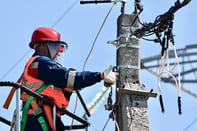Published on
The Workforce of the Future Needs Innovative Education

As an hourly worker in an automotive manufacturing facility in Michigan, I began to recognize that I was experiencing the end of the industrial revolution and the emergence of the information and technology revolution. I began to experience fluctuations in employment–periods of being laid off and returning to work for many months at a time. As a young wife and mother, I decided to pursue an education that I thought would relate to my workplace and provide an opportunity to advance within my company. I studied industrial drafting and computerized numerical control at my local community college.
During that time, I remember walking through the plant and seeing how automation was replacing mentally and physically challenging positions. For example, I often talk about an area called the hood welder. In this part of the factory, the automobile hood was spot welded by humans, but human welders only now do about 10% of that work. Most of the hood welding process was automated with robots and other automation systems. As a result, many low skilled production workers lost their jobs or took early retirements.
After completing my degree, I also took an early retirement when offered a job at the local community college. However, I continued to work as a mechanical designer with automotive suppliers part time, while working at the college and continuing my advanced degrees. My career at the college progressed and eventually I joined the faculty, then administration. As an administrator, I was charged with assisting in the design and construction of a new campus to support two new General Motors factories. This work allowed me to continue working with automakers in Michigan. Over time, we developed a partnership with Toyota to support their goal of a national center of excellence in automotive manufacturing to train a high-skilled workforce for the automotive industry. In 2008, the center of excellence became a reality and grew to support most of the large global automakers with plants in the United States.
In this work, we learned many jobs were being automated, yet the demand for highly skilled technicians in the automotive sector was an issue. During the years of layoffs, some of the employees who left were the most skilled technicians. These technicians had many options, including ones offering them a competitive wage. Does this story sound familiar? I gave you this background to set the stage for what is happening still today with automation and what it means to the workforce of the future.
Pre pandemic, think tanks were researching the acceleration of technology in the workplace, as many feared technology and artificial intelligence would eliminate work as we know it today. As a result, in 2018, the Massachusetts Institute of Technology (MIT) launched a bold study with many of our nation’s brightest faculty and an advisory committee of business and education thought leaders, with the goal of “understanding the relationships between emerging technologies and work, to help shape public discourse around realistic expectations of technology, and to explore strategies to enable a future of shared prosperity”[i]. I was privileged to be on the advisory committee.
The MIT study found that even as technology continues to advance, there is still a need for a highly skilled workforce. We learned that as technology changes, the nature of work creates new jobs and skills that require agility and resiliency as the job market shifts. The changing nature of work reinforces the need for education as a lifelong venture—with short-term credentials and advanced degrees.
The National Science Foundation (NSF), Advance Technological Education (ATE) funded a project with the Center for Occupational Research & Development called Preparing Technicians for the Future of Work, DUE 1839567. Findings from this project provided guidance for the key role of our nation’s community colleges. The project findings, published in Making the Case for a Cross-Disciplinary STEM Core, have identified essential cross-disciplinary knowledge and skills for future STEM workers. This cross-disciplinary knowledge and skills are described in broad areas of focus: advanced digital literacy, data knowledge and analysis, and business knowledge and processes. As the author states, “These core content areas are essential to future success in STEM fields because they transcend narrow job specialization and enable technicians to adapt to a complex employment environment.”[ii]
As we embrace supporting education and training in the future, we must not forget that poverty and access issues have not changed since I left the automotive industry. So, how do we ensure that everyone, including those in low-skill, low-wage jobs and generational poverty are not left behind? COVID-19 exacerbated the challenges that front line workers in low-skill and low-paid job have faced. At the same time, employers are experiencing workforce shortages, and have accelerated the adoption of automation as a result. As the MIT study was challenged to do, “We must understand the relationships between emerging technologies and work, to help shape public discourse around realistic expectations of technology and explore strategies to enable a future of shared prosperity”[iii].
To ensure a workforce of shared prosperity, we must expand our reach and offerings to those who are underemployed. We must be able to deliver short-term industry credentials focused on expanding students’ knowledge, skills and abilities, so they can be agile and resilient to changes in technology. But our biggest challenge is becoming a place that serves first-generation, low-income and underemployed adults. These students will arrive at our colleges, just as I did, with families and children. As a result, we will need a college that supports their need to work, learn and earn simultaneously. Finally, we must provide wraparound services to address everyday challenges (or global ones) that may prevent a student from completing their goals.
References
[i] Autor, D., Mindell, D., & Reynolds, E. (2020, November 17). The Work of the Future: Building Better Jobs in an Age of Intelligent Machines. MIT Work of the Future. Retrieved October 19, 2021, from https://workofthefuture.mit.edu/research-post/the-work-of-the-future-building-better-jobs-in-an-age-of-intelligent-machines/
[ii] (Cotner, H. (2021, October 13). A Framework for a Cross-Disciplinary STEM Core. PreparingTechnichians.org. Retrieved October 19, 2021, from https://www.preparingtechnicians.org/making-the-case-for-a-cross-disciplinary-stem-core/).
[iii] (Autor, D., Mindell, D., & Reynolds, E. (2020, November 17). The Work of the Future: Building Better Jobs in an Age of Intelligent Machines. MIT Work of the Future. Retrieved October 19, 2021, from https://workofthefuture.mit.edu/research-post/the-work-of-the-future-building-better-jobs-in-an-age-of-intelligent-machines/)
Disclaimer: Embedded links in articles don’t represent author endorsement, but aim to provide readers with additional context and service.
Author Perspective: Administrator



